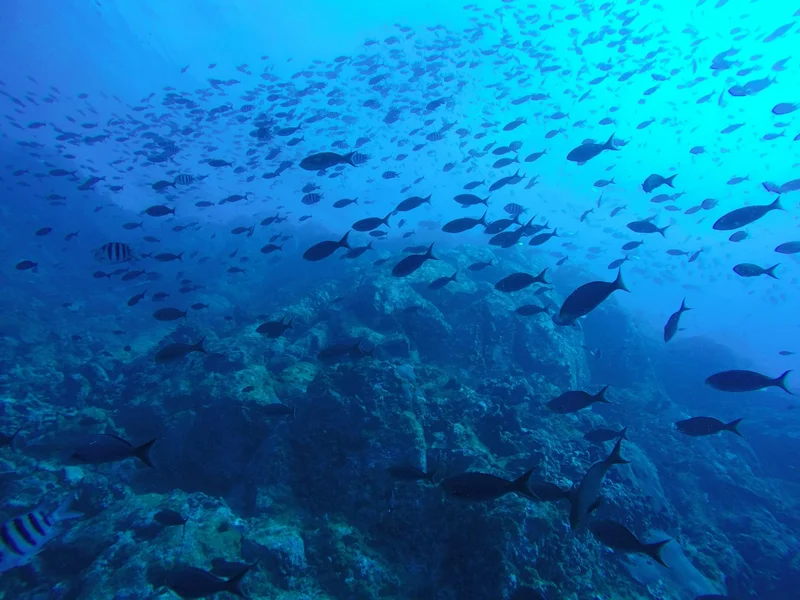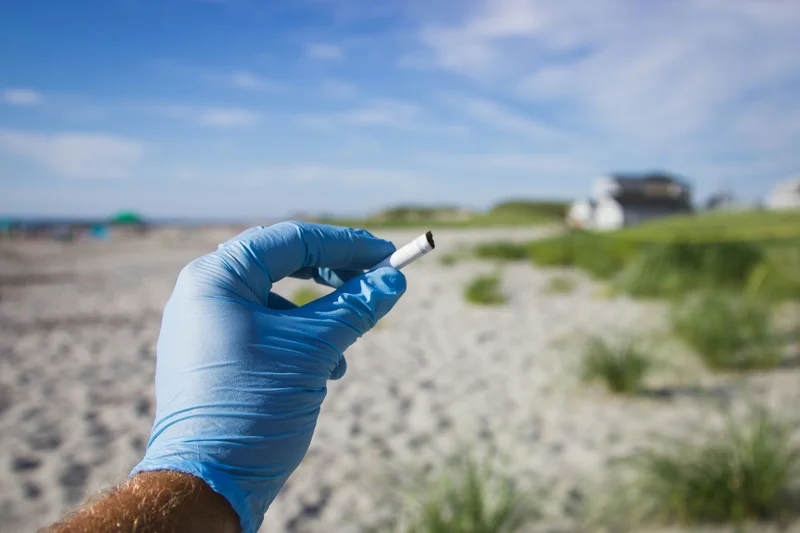Drowning in an ocean of cigarette butts
The vast majority of cigarette waste ends up in nature, where it breaks down into microplastics, releases toxic substances, or is ingested by wildlife. Cigarette waste is a wave of pollution that costs USD 26 billion per year.
More than 766,500 tonnes. That is how many cigarette butts end up in the environment each year. Of the 6 billion cigarettes produced per year, an estimated 5.6 billion are discarded inappropriately.[1] “Butts systematically top the list of objects most often collected by municipal services or during beach clean-up days,” notes Thomas Novotny, a public health and environmental specialist at the University of San Diego (US), who focuses his research on tobacco.
Of the 10 million pieces of trash collected during the International Coastal Clean-up Campaign in 2009, 21% were cigarette butts.[2] According to a count done on the beaches of northern Belgium between 2019 and 2021, this proportion even rose to 41%.[3] Carried by sewers and waterways, they tend to accumulate there before ending up on beaches and in the oceans. Due to their small size, they are difficult for road clean-up services to collect.

In Switzerland, scant data is available on the number of cigarette butts scattered in the environment. But during a two-week campaign organised in 2021 by Stop2Drop, an initiative whose impetus came from a class in Bern, 960,000 cigarette butts were collected by schoolchildren across the country. “We repeated the project in 2023, obtaining 540,000 butts,” relates Markus Dick, who runs Stop2Drop. In 2022, the organisation also analyzed 42 play areas. “We found more than 400 cigarette butts in four of them,” he says. He specifies that in Switzerland, too, cigarette butts are the object most frequently littered into the environment.
The problem is even more acute in developing countries, “where the proportion of smokers is often higher and whose road clean-up services are sometimes deficient, or even non-existent,” notes Debbie Sy, in charge of strategic affairs for Global Center for Good Governance in Tobacco Control. China, Indonesia, Bangladesh, the Philippines, Vietnam, Thailand, Brazil, Egypt, India, Russia, Iran, and Pakistan are particularly affected.[4]
Note that each butt is made up of some 15,000 filaments of cellulose acetate measuring less than 0.2 millimetres each. While resting in the wild, it loses around a hundred per day.[5] Photodegradable but not biodegradable, that is to say it reacts to the sun’s ultraviolet rays, a cigarette butt takes on average 10 years to dissolve.[6]
“But it doesn’t really disappear,” notes Debbie Sy. “Rather it disintegrates into thousands of tiny pieces.” These microplastics are often ingested by birds, fish, and other aquatic organisms, thus entering the food chain, she notes. Microplastics are also found in drinking water.[7] In addition to cigarette butts, the transparent polypropylene cases used to wrap cigarette packets and cartons represent another source of polluting microplastics.


Yet more serious, cigarette butts spread many harmful substances into the environment. “They are like so many little tea bags which gradually release their toxic load into the soil and water,” notes Thomas Novotny, who recalls that a cigarette contains more than 7,000 chemicals, including around 50 that are carcinogenic. Added to this are some 600 additives to supposedly improve the taste or texture of tobacco, as well as fertilizers and pesticides absorbed by tobacco leaves during cultivation.
Among the most dangerous substances for the environment are nicotine; nitrosamines specific to tobacco, including several carcinogenic substances; heavy metals such as arsenic, lead, aluminum, nickel, titanium, copper, chromium, mercury, and iron[8]; polycyclic aromatic hydrocarbons (PAHs); aromatic amines; and BTEX chemicals (benzene, toluene, phenols).[9]
“Their toxicity on aquatic life has been demonstrated dozens of times in laboratory experiments,” notes Debbie Sy. In some cases, adding only one cigarette butt to a litre of water was enough to produce a fatal effect on organisms.” Two fish, the barred silverside and the bighead shiner, notably exhibited a mortality rate of more than 50% after just 96 hours.[10]
Other experiments have shown the impact of cigarette butts on the survival, growth rates, and reproductive capacity of other fish, invertebrates, crustaceans, aquatic snails, and amphibians. “We must not forget that some of these species are consumed by humans,” explains Thomas Novotny. If toxic substances accumulate in their body, they risk entering the food chain.
On land, butts have the effect of reducing the germination rate and the size of the shoots of certain plants.[11] Sparrows, which frequently use cigarette scraps to build their nests, exhibit genetic mutations in their red blood cells.[12]
Young children and pets also tend to ingest them by mistake, which can cause vomiting, seizures, cardiac arrhythmias, and respiratory arrest. A single cigarette contains between nine and 30 milligrams of nicotine, while the toxic dose for a toddler is one to two milligrams; 40 to 60 milligrams is fatal.[13]
Butts littered into the environment are also responsible for other bad outcomes. They can block waterways, exacerbating flooding, and piles of stagnant cigarette residue encourage the breeding of mosquitoes that spread malaria.[14] Poorly extinguished cigarette butts also represent the most frequent cause of accidental fires, particularly forest fires. In the United States, 8 to 10% of fires start this way. The problem is compounded because substances are added to cigarette paper so that cigarettes stay lit.[15]
The pollution caused by the spread of cigarette remains costs USD 26 billion per year, according to a calculation by Debbie Sy, who included road clean-up costs and environmental damage.[16] In the United States, this amount to USD 400 million per year.[17] In France, 100 million euros per year.[18] “In Switzerland, the Federal Office for the Environment estimated in 2011 that authorities spent CHF 52 million per year to collect cigarette butts,” adds Markus Dick.
But how can we explain why so many smokers litter their cigarette butts into nature? “There is a lot of ignorance among the public about the toxicity of cigarette waste,” notes Thomas Novotny. “When we survey smokers, many of them think that cigarette butts are made of paper or cotton and will degrade naturally.” During a session with smokers organised by RJ Reynolds, a subsidiary of British American Tobacco that markets the Camel and Pall Mall brands in the United States, some smokers suggested placing the filters in the compost to dispose of them; others suggested creating edible filters made from mint candy or cookies.[19]

Some smokers “don't want to carry leftover cigarettes in a portable ashtray or in their car ashtray because they find them dirty,” says Chris Bostic, director of public policy for Action on Smoking and Health (ASH). Others fear causing a fire by throwing their cigarette butts in a trash can, he adds. More pernicious, “smokers are sometimes reluctant to use an ashtray because they don’t want to be confronted with this visual reminder of their addiction,” underlines Thomas Novotny. Some see littering as a natural extension of the rebellious attitude that led them to smoke in the first place.
An observational study carried out in 130 locations in the United States showed that 45% of cigarettes smoked were thrown on the ground.[20] When we survey smokers about their habits, this proportion even rises to 65%.[21] Other surveys have found that even when they are within five metres of an ashtray or trash can, smokers do not use them. Far from placing the responsibility for this pollution on the shoulders of smokers, these results lead to a simple observation: cigarette filters are toxic and must be banned.
[1] https://pubmed.ncbi.nlm.nih.gov/21504919/
[3] https://pubmed.ncbi.nlm.nih.gov/38026410/
[4] https://ggtc.world/library/tobaccos-toxic-plastics-a-global-outlook
[5] https://www.sciencedirect.com/science/article/abs/pii/S0048969721034550
[7] https://journals.plos.org/plosone/article?id=10.1371/journal.pone.0194970
[10] https://tobaccocontrol.bmj.com/content/20/Suppl_1/i25
[11] https://www.sciencedirect.com/science/article/abs/pii/S0147651319307481
[13] https://tobaccocontrol.bmj.com/content/20/Suppl_1/i17
[14] https://ggtc.world/library/tobaccos-toxic-plastics-a-global-outlook
[15] https://exposetobacco.org/resource/ti-and-environment/
[16] https://tobaccocontrol.bmj.com/content/early/2023/11/07/tc-2022-057795
[17] https://ggtc.world/library/tobaccos-toxic-plastics-a-global-outlook
[18] https://www.drugsandalcohol.ie/37966/1/WHO_Tobacco_poisoning_our_planet.pdf
[19] https://www.industrydocuments.ucsf.edu/tobacco/docs/#id=yrfl0089
[21] https://journals.sagepub.com/doi/abs/10.1177/0013916511412179